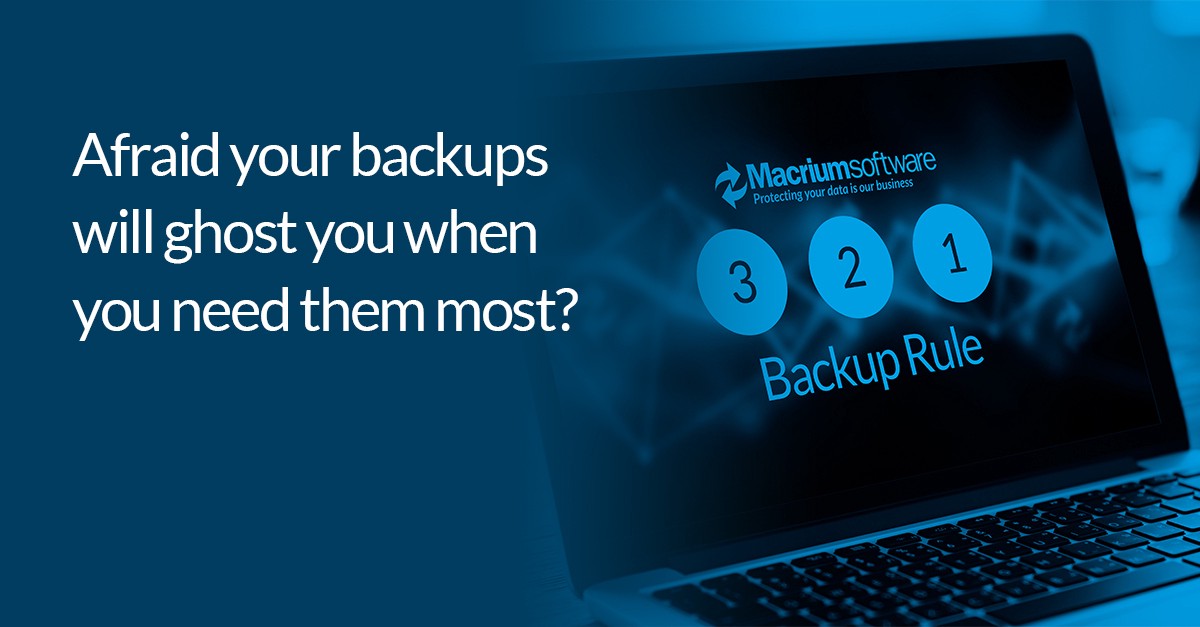Afraid your backups will ghost you when you need them most?

Do you know the most important step in the entire back up process? Recovery. After all, what’s the point of running a backup on a regular basis if you’re unable to restore your data?
Many people think scheduling a regular backup is good enough — set it and forget it, so to speak. But you wouldn’t install a home security system and not regularly check to make sure it’s operating correctly, would you? Smoke and CO2 detectors, direct debits to pay the bills, air pressure in your tires… there are plenty of things in life that require a little maintenance, and your backups are no different. Here’s a good data disaster horror story.
Was Toy Story 2 cursed?
Back in 1998, the movie studio Pixar was just making a name for itself. They’d released their first feature-length film, Toy Story, and were hard at work creating the sequel. On one fateful day, they noticed a few of the files had gone missing. After refreshing the folder, more files were gone. Files vital to the animations of Woody, Buzz and the rest of the gang were disappearing right in front of their eyes!
Someone on the team, somewhere, had inadvertently run a command at the root level of the production. Like a fast moving fire, it cascaded through the system, recursively traveling through the directory and deleting everything in its path. By the time they shut down the main servers to stop it in its tracks, 90% of the film was gone.
With the initial panic over, they set to restoring to their last backup. The problem was, while they did have a backup system in place, they weren’t regularly checking it to make sure everything was running correctly. They’d maxed out their storage (which at the time was only four gigabytes), and while their backup system was technically running perfectly, each backup would bump the older content off the drive. After a week of trying to recover the full film, and encountering a host of errors and missing files, they realized they couldn’t have any confidence in their backed up files.
This could’ve been the tragic end to the Toy Story franchise, but by sheer chance, the Supervising Technical Director had been working from home following the birth of her son. Her home computer was unaffected by the issues in the office network, leaving a complete copy of the film, albeit a few weeks behind the original. After a tense transit of her computer to the office, they managed to verify most of the files, leaving a mere 30,000 to comb through by hand over the course of a weekend.
If Pixar had maintained proper backup protocols this near-disaster could’ve been avoided. What amounted to weeks of lost productivity, 72 hours of eye-blurring recovery, not to mention the extreme stress of the loss, should’ve been a quick and easy restoration.
Act now to prevent a data loss nightmare
The good news is that it doesn’t take a lot of time or effort to maintain industry best practices with your backups. With a small amount of planning now, you can create a system that works for you and eliminates pretty much every disaster you could encounter. In fact, it’s as easy as 3–2–1.
3 copies
Maintain three copies of your data, and ensure they’re as up to date as you’re comfortable with. Whether that’s a full backup every month, week, or day entirely depends on how much you feel comfortable losing inbetween. And with Macrium Reflect 7 Home Edition, you have the flexibility of creating schedules for your full, differential, and incremental backups. Obviously, the more copies you have, the safer you are, but that’s only part of the plan.
2 different media types
Keeping three different copies stored on the same hard drive or server isn’t logical. Whatever disaster that might strike one could hit all three, whether that’s a hardware failure, environmental event like a fire, or a virus. To protect yourself, maintain at least one version of your data stored in external storage like a USB stick or a portable hard drive.
1 offsite copy
It doesn’t take a lot of imagination to picture a scenario where both a computer and a USB drive are damaged beyond repair. Just as in the above story, the absolute safest method of protecting your data is to keep a copy of it separate from the others. This can be as simple as a second external hard drive kept at work, or a cloud storage solution (although these can get quite pricey).
Most importantly
And with all that in place, we return to the most critical part — recovery. On a regular basis, make sure to check each of your copies is fully restorable. You already understand the importance of running backups, so the good news is Macrium Reflect’s Rapid Delta Restore and Rapid Delta Clone make it possible to recover your data quickly and efficiently should you ever have to!
Click here if you’d like to learn more about Macrium Reflect Home Edition, buy licenses to protect your whole household, and join millions of others in protecting their most valuable data.

